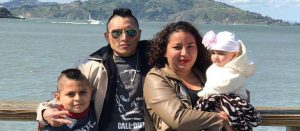 Immigrating together can definitely form a strong bond. Such was the case for Yeimy Moreno and Orlin Salazar, who separately decided to leave their native Honduras in search of a better life to the north. The bond formed put these émigrés on the path to becoming a family, but that did not happen overnight.
Immigrating together can definitely form a strong bond. Such was the case for Yeimy Moreno and Orlin Salazar, who separately decided to leave their native Honduras in search of a better life to the north. The bond formed put these émigrés on the path to becoming a family, but that did not happen overnight.
Yeimy wound up in the Northern California farming town of Watsonville, which offers a strong Latino immigrant community, while Orlin and his 8-year-old son, Dannis, headed to San Francisco’s Mission for the same reason.
Despite being 100 miles apart, Orlin could not forget Yeimy, so he started an online search — a search that eventually proved successful. A reunion turned into a permanent relationship.
The now close-knit Moreno-Salazar family rented a small bedroom in a three-room apartment on Cesar Chavez Street in San Francisco’s Mission District, with the relatively low rent supported by Orlin’s work cleaning restaurants at night, while Yeimy took care of Dannis. All was moving along until the family learned that the building was going to be demolished, effectively being taken off the rental market. The challenge of finding new affordable housing began with this no-fault eviction. Further complicating the situation was that Yeimy had given birth just two months prior to daughter Brittani, which meant this was now a family of four in search of affordable housing in the Bay Area. No easy task.
Yeimy had always been proactive in seeking assistance, which is why she came to Family Success Coach Yadira Diaz, based at Dannis’ school, Cesar Chavez Elementary, one of a quartet of Mission Promise Neighborhood schools. (MEDA is the lead agency of the Mission Promise Neighborhood.) Diaz acts as a connector to services in the Mission.
Yeimy feared her family would wind up on the street.
Knowing the difficulty of locating a permanent residence the family could afford — especially when trying to find a landlord open to accepting a housing subsidy — Diaz helped them secure a temporary spot at a Hamilton Families shelter. The search continued, a diligent Yeimy daily scouring Craigslist ads, enlisting the counsel of Diaz on which apartments seemed appropriate for the family. Diaz then passed on the best options to Hamilton Families caseworker Miguel, who ascertained how the housing subsidy could be put to best use.
While this process was taking place, Diaz was busily connecting Yeimy to other services to strengthen her family. When Dannis starting exhibiting behavioral issues, possibly attributed to leaving his homeland, Instituto Familiar de la Raza’s services made sense. The youngster was also awarded a special slot in Jamestown Community Center’s after-school program because of the family being in the extreme situation of being in a shelter; that organization offers age-specific support groups as a means to bettered academic achievement.
Another problem was that Diaz determined the Moreno-Salazar’s were unbanked, an especially egregious issue because they were carrying around money they had received from the landlord when they were evicted. Being unbanked is often an issue with newcomers, who often have an inherent mistrust of their new country’s financial institutions. That’s where MEDA’s Financial Asset Program Manager Jackie Marcelo’s came into play, getting the family set up with an account at Self-Help Federal Credit Union, located in the heart of the Mission and with an ongoing offer of just $5 to open a savings account.
The good news is that the determined family finally found a new home — a rental located in Oakland. This was an exhaustive, eight-month search from the time of the initial eviction notice.
Diaz then connected Yeimy to the Families & Youth in Transition (FYIT) program via SFUSD. FYIT is providing the Moreno-Salazar’s with assistance procuring BART passes, now needed so Dannis can get to school in San Francisco’s Mission, plus uniforms and much more.
Always looking to learn and better her family’s life, Yeimy is also looking to better her English-language skills by taking classes at Good Samaritan Family Resource Center. Additionally, Diaz has connected her to Mission Neighborhood Centers to eventually put her infant daughter in quality child care so that Yeimy can start working outside the home.
“Yeimy is resilient. She’s a doer. I am proud to be part of a Family Success Coach team for the Mission Promise Neighborhood, connecting families to free, culturally relevant services that will better their lives so their children can succeed in school,” concludes a zealous Diaz.
___________________________________________________________
About Mission Promise Neighborhood
The Mission Promise Neighborhood is a citywide community partnership that was created to support kids and families living, working and attending school in the Mission District. It brings together schools, colleges, community organizations and community leaders to help kids graduate and families achieve financial stability.




